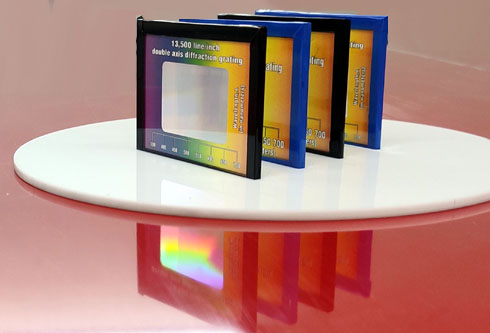Diffraction Grating

Diffraction Grating
This Diffraction Grating Is Particularly Recommended As It Enables Measurements To Be Taken Of The Separation Of Nad Lines. Also Used For The Separation Of Spectra In Colour Demonstrations As It Is Strongly Blazed In The First Through Fifth Orders. It Provides A Sharp, Brilliant Spectrum And Is Excellent For Projecting A Spectrum As A Classroom Experiment. These High Quality Gratings Have A High Resolving Power And Are Suitable For Use In Quality Student Spectrometers.
Mounted On Glass Plate 50 X 38 X 4 mm. Diffraction Grating Area 25 mm Sq. This Grating Is Strongly Blazed In The First Order Only. The 600l/mm Spectrum Is Sharp And And Bright, But Not As Concentrated As The 300 L/mm Grating.
Size: 50 X 38 mm
25 X 25 Mm
Available In 100, 200, 300, 600, 2500, 5000, 7500, 12000, 15000, 25000, Diffraction Grating lines Per mm.
The Grating Is Protected By
Two Glass Plates 50 X 38 mm And Bound Together At Edges.
Grating Area 25 X 25 mm.
Types of Gratings
Gratings are produced by two methods, ruling and holography. A high-precision ruling engine creates a master grating by burnishing grooves with a diamond tool against a thin coating of evaporated metal applied to a surface. Replication of the master grating enables the production of ruled gratings, which comprise the majority of diffraction gratings used in dispersive spectrometers. These gratings can be blazed for specific wavelengths, generally have high efficiency, and are often used in systems requiring high resolution. Echelle gratings are a type of ruled grating that are coarse, i.e., low groove density, have high-blaze angles, and use high diffraction orders. The virtue of an echelle grating lies in its ability to provide high dispersion and resolution in a compact system design. Overlapping of diffraction orders is an important limitation of echelle gratings requiring some type of order separation typically provided by a prism or another grating. Holographic gratings are created using a sinusoidal interference pattern which is etched into glass. These gratings have lower scatter than ruled gratings, are designed to minimize aberrations, and can have high efficiency for a single plane of polarization. Gratings can be reflective or transmissive, and the surface of a grating can either be planar or concave. Planar gratings generally give higher resolution over a wide wavelength range while concave gratings can function as both a dispersing and focusing element in a spectrometer.
